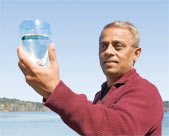On tap today...
UVic researchers flush out unsettling truths about water quality in some BC communities

By Peigi McGillivray
For Dr. Asit Mazumder, there’s a lot more to drinking water than what comes out of the tap.
“Canada has the world’s largest source of fresh water,” he says. “But more and more, communities across the country are struggling to keep their drinking water clean and safe. Even here, where lakes and rivers are plentiful, we can’t take our fresh water for granted.”
Mazumder is an aquatic ecologist at the University of Victoria and a world leader in tracking the sources of chemical and microbial contamination of water. He’s known locally for his work with Victoria’s Capital Regional District, where he has helped develop greater scientific understanding of the ecological factors that affect the quality and safety of our tap water.
Southern Vancouver Island provides a unique natural laboratory for this kind of work. There’s the Sooke reservoir—which provides Greater Victoria’s drinking water—sitting in a pristine watershed that has been protected for more than 100 years.
And a mere five kilometres away there’s Shawnigan Lake, an unprotected source of drinking water that is affected by logging, permanent and summer homes, agriculture and various recreational activities.
“Nowhere else in the world can you compare two drinking water sources that are so close and alike, yet so different in water quality,” he says.
To assess whether a body of water is contaminated, Mazumder and his team have developed a tool that measures the geochemical, biochemical and microbial signatures, or traces, of septic and sewage outflows.
“One of the chemicals we look for is caffeine,” he says. “When we find it, we know that the water is being contaminated by human waste through septic field seepage or sewage input.”
Last spring, Shawnigan Lake residents were shocked to find out from Mazumder and his team that detectable levels of caffeine and pharmaceuticals had been found in their lake.
“Until then, they had no idea they were drinking lake water contaminated by septic seepage,” says Mazumder. “The community is much more aware now, and is working on improving the situation. Our simple ‘caffeine detection’ tool gives them an easy way to assess fecal contamination and associated health risks from their drinking water.”
The UVic research suggests that this kind of contamination is common in freshwater lakes, rivers and streams bounded by septic fields or receiving untreated sewage.
“Even sewage treatment—like the system being planned for Victoria—would not remove pharmaceuticals, toxic heavy metal compounds or persistent organic pollutants from the water,” stresses Mazumder.
“We have to stop these chemicals from getting into the water in the first place.”
To date, more than 20 BC communities, 14 Aboriginal communities across Canada, and communities in Bangladesh, Haiti and Cambodia have been using the science and tools developed by Mazumder’s lab to track sources of contamination and improve water quality.
“Fresh water is one of the world’s most precious natural resources. None of us can exist without it,” says Mazumder. “Our work at UVic is directly linked to our environment, our health, our quality of life and the future of our communities. It’s very rewarding to be involved in research that contributes so significantly to people’s health.”
View as PDF (208K).
- UVic’s Water and Aquatic Sciences Research Program is a community-based research initiative funded by the Natural Sciences and Engineering Research Council (NSERC), water departments including the CRD and Nanaimo, several federal departments and agencies, and many small to large communities. For more information, visit web.uvic.ca/water/.
- Asit Mazumder’s research team includes graduate and postdoctoral scientists and undergraduate and co-op students. “In my teaching, I don’t use textbooks,” he says. “Students learn not only the theoretical basis of the work we’re doing, but gain invaluable hands-on experience.”
- Here’s what you can do to help: if possible, switch from a septic field to an environmentally acceptable sewage system; have your septic tank inspected every year and pumped out every 3–5 years; avoid using in-sink garbage disposals; and don’t use the toilet as a garbage can.
- UVic researchers were awarded more than $106 million in outside research grants and contracts in 2007/08. This more than doubles the research support of five years ago.
